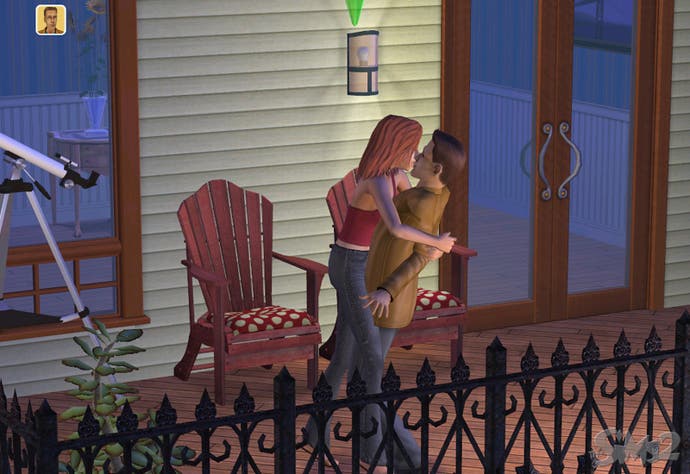The History of The Sims
Tiny happy people.
The Sims: Livin' It Up was the first, and allowed players to have five neighbourhoods on the go at once. It also introduced the now-familiar concept of wacky NPC characters, including Sunny the Tragic Clown, who appeared to torment depressed Sims with his crap antics. House Party expanded the social options for Sims, enabling them to throw a party rather than simply phoning a string of friends and inviting them around. Hot Date introduced Downtown, the first external location added to the game, where Sims could go on romantic excursions. Vacation took the idea further, offering various holiday destinations for weary Sims, while Unleashed introduced pet cats and dogs to the game for the first time. With Superstar, it seemed that the expansions were starting to rely more on novelty than necessity, as Sims were able to travel to Studiotown and become celebrities. The final expansion for the original Sims, Makin' Magic, pretty much confirmed this - adding little beyond silly magic tricks, and shamelessly cashing in on the Harry Potter mania that had snowballed since the original's release.
For those who wanted to add some variety to their game, but didn't want to fork out for an official expansion, fans were soon using Maxis-approved tools to clog up the Internet pipes with their own character skins and furniture designs. Copyright infringement on a massive scale inevitably ensued and, as an unemployed layabout in 2000, I can openly admit to spending more time than is healthy painstakingly crafting a street where Dr Zaiuss from Planet of the Apes shared a house with RoboCop, and lived next door to The A-Team. Such are the dreams of modern man.

With these little computer people firmly established, the question became where they could go next with the concept. In 2002 everyone was still awfully excited about the whole information superhighway thing, and so it came to pass that The Sims went online in the self-explanatory The Sims Online. The result was...gruesome. In this pre-broadband era, when downloading a nude JPEG of Marina Sirtis could take many agonising minutes, the infrastructure just wasn't there to support the infinitely malleable persistent virtual world that The Sims required and few felt it was worth the GBP 7.99 per month they were charging to play. "There's no way to give your little Sim the financial and social freedom the whole fantasy is based on," grumbled Baby Tom, then just ten-years-old, in a review that he adorably wrote in red crayon. Bless.
The Sims Online story doesn't end there though. While official support for the game dried up within a year of launch, the game servers remained active and in February of this year the core Sims Online code was reworked and relaunched as the rather corporate sounding EA-Land. Access to the Beta of this bold new frontier is now free, for those who can be bothered to make their way through the rather clumsy registration and installation process. It's still basically The Sims Online so, in other words, it's Second Life except everyone is reading books and washing up rather than running around with sunglasses, angel wings and nine-foot swords. I spent a pleasant hour or so wandering around what appeared to be a sanctuary for Danish internet lesbians, none of whom seemed remotely interested in the pot-bellied ant-headed intruder that had suddenly spawned in their midst. Hey, it's free. Can't complain.

With the Internet remaining an elusive minx, The Sims brand instead turned its world-conquering attention to the consoles, grazing quietly by the watering hole. The original Sims reached the PS2, Xbox and GameCube in early 2003, the first title in the series developed exclusively for console players. Hampered by the lack of a hard drive, the console versions took the framework of the game - building, buying and directing the life of your Sims - and bolted it onto the sort of goal-oriented gameplay that console gamers apparently prefer. While the freeform options of old were still present, most of the gameplay now revolved around adopting a Sim in a specific scenario and guiding them to lifestyle success.
January 2004 saw the series' second console outing, The Sims: Bustin' Out, which once again graced the big three consoles of the time as well as the GameBoy Advance and - good lord - the N-Gage. Yes, EA wouldn't support the Dreamcast, but brought its biggest franchise to the sodding N-Gage (and you wonder why The Kids turned against them). Anyway, Bustin' Out was basically The Sims' previous console version, with the Livin' It Up expansion slapped on as well. Such shenanigans didn't work as well with the console crowd, given that the resulting package cost twice as much as its PC equivalent, and even the year gap between the releases did little to endear this repackaging to fans. Having awarded the original PS2 port an enthusiastic 8/10, that score had dipped to 6/10 by the time Bustin' Out arrived. "I'm bored of The Sims," sulked Tom, who had now gone from precocious moppet to petulant teenager. They grow up so fast, don't they?
